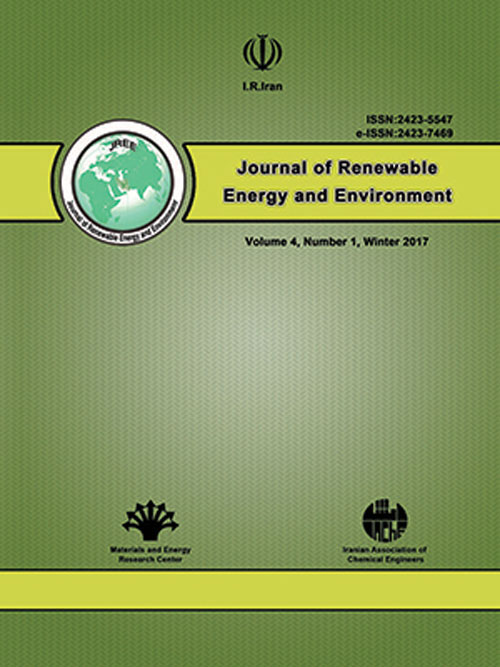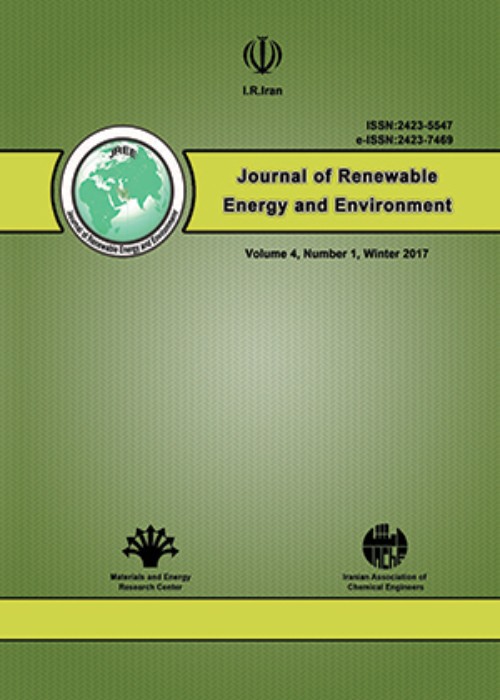فهرست مطالب

Journal of Renewable Energy and Environment
Volume:6 Issue: 4, Autumn 2019
- تاریخ انتشار: 1398/07/09
- تعداد عناوین: 6
-
-
Pages 1-9The modern BioElectrochemical technologies can convert the energy stored in the chemical bonds of biodegradable organic materials to renewable electrical energy through the catalytic reactions of microorganisms while treating the waste waters. The present research was conducted to evaluate the efficiency of a single-chamber Bioelectrochemical system with the carbon aerogel catalyst, as a simple and inexpensive method, in removing the corrosive and odorous sulfur compounds from municipal wastewater simultaneously with electricity generation by using indigenous bacterial consortium. The used bacteria were isolated from local lagoon sediments, and the municipal wastewater was used as the substrate. During six months of the Bioelectrochemical cell operation, the sulfate concentration was dropped to a minimum of 63 ± 57.2 mg/l, indicating the ability of the system to remove 71.8 % of the sulfate from the municipal wastewater and the production of bioenergy. With a 304 mV Open Circulate voltage, the maximum removal of Chemical Oxygen Demand was 80 % and the maximum power density was 1.82 mW/m2. Carbon aerogel, as a novel material with suitable absorbance and resistance to oxidation at urban wastewater pH, can be, therefore, coated on electrodes to facilitate the Oxidation Reduction Reactions and electricity transmission. The existence of elemental sulfur in the sediments showed that these systems could be optimized to recover the elemental sulfur from the municipal wastewater.Keywords: waste water purification, Renewable Energy, carbon aerogel, BioElectrochemical System, air cathode
-
Pages 10-15Glycyrrhiza glabra residue (GGR) was efficiently subjected to concentrated phosphoric acid (PA) pretreatment with/without surfactant assistance, and promising results were obtained following separate enzymatic hydrolysis and fermentation (SHF) of the biomass. Pretreatment was carried out using 85 % PA either at 50 or 85 °C with 12.5 % solid loading for 30 min. In parallel experiments, the intact GGR was impregnated in 2 % (w/w) surfactant (Polyethylene glycol) aqueous solution prior to the PA pretreatment. Consequently, the pretreated materials were subjected to enzymatic hydrolysis (50 °C, 72 h) using 25 FPU/g cellulase, and the most digestible biomass was nominated for conversion to bioethanol. Substantial improvement in digestibility of GGR (~92 % hydrolysis yield) was observed following surfactant-assisted PA pretreatment, whereas digestibility yield from the untreated biomass was only 16.1 %. Consequently, the ethanol production form GGR was significantly enhanced by 19.7-fold through separate hydrolysis and fermentation of biomass. Different analytical approaches including water retention value, Simons’ staining, and crystallinity together with FESEM imaging revealed that the improved surface hydrophilicity, increased substrate accessibility to enzyme, and decreased crystallinity could be the major effects of PA pretreatment, leading to higher susceptibility of GGR to enzymatic hydrolysis and subsequent ethanol production.Keywords: Bioethanol, Glycyrrhiza glabra residue, Phosphoric acid pretreatment, Surfactant, Simons’ stain
-
Pages 16-26In this study, the effects of JP-4-biodiesel-diesel blends and engine operating parameters on the performance characteristics of a diesel engine were investigated. The experimental tests were performed on a four-cylinder DI diesel engine. The Mixture-RSM method was applied to develop the mathematical models based on the experimental data. The results showed that the fitted models could be properly applied to predict the performance characteristics of the engine. According to the results, the brake power and torque decreased with increasing the biodiesel amount in the fuel mixture due to the lower energy content and higher viscosity of biodiesel than diesel fuel No.2. However, the brake power and torque increased slightly with increasing JP-4 in the fuel blend. The results also indicated that the BSFC increased with the higher proportion of biodiesel in the mixture at all engine speeds. The results indicated that there was no considerable difference in BSFC values while JP-4 was added to the fuel mixture, especially at higher engine speeds. Moreover, the difference of brake power values for fuel blends included biodiesel and neat diesel decreases at higher engine speeds due to the positive role of oxygen content in the molecular structure of biodiesel. Based on the results, brake power and torque increased at the higher engine load as a result of higher temperatures and better combustion conditions. Moreover, JP-4 caused an improvement in brake thermal efficiency compared to biodiesel, especially at lower and medium engine speeds. Generally, it is indicated that the application of JP-4 can improve engine performance.Keywords: JP-4, Biodiesel, performance, Mixture-RSM, Diesel engine
-
Pages 27-34The effect of Al2O3 (1-10 wt %) and Y2O3 (1-10 wt %) additions on thermochemical heat storage properties of Co3O4/CoO system was investigated by thermogravimetry, XRD, and SEM analyses. Results showed that the addition of Al2O3 to Co3O4 at constant 8 h mechanical activation improved the redox cycle stability and increased oxygen sorption value and rate. It was found that oxygen sorption and their rate decreased with increasing the alumina content to more than 8 wt %. The formation of the spinel phase and an increase in its amount by increasing the alumina content led to a decrease in the oxygen sorption capacity. SEM studies showed that Al2O3 prevented the sintering and particle growth of cobalt oxide particles during reduction and re-oxidation processes. In addition, results showed that the addition of Y2O3 in all ranges to Co3O4 improved the redox cycle stability of cobalt oxide; however, it significantly decreased the oxygen sorption in the Co3O4/CoO system. XRD patterns of a sample containing 10 wt % yttria before the redox process indicated the presence of only Co3O4 phase; however, after three redox cycles, other phases including CoO and Y2O3 appeared.Keywords: Cobalt oxide, heat storage, Thermochemical, Sintering, Cycle stability
-
Pages 35-40Agricultural residues are potential renewable biomass sources for bio-energy production. The objective of the work is to determine the pyrolysis kinetic parameters of corn cob biomass. Three different heating rates of 10, 20, and 30 °C/min were taken into account in the thermogravimetric analysis. The Kissinger, Flynn Wall Ozawa (FWO), and Kissinger Akahira Sunose (KAS) model-free methods were employed to calculate the kinetic parameters by the use of the data obtained from TGA. The thermal decomposition process shows three basic phases of pyrolysis: removal of moisture content, primary and secondary pyrolysis. The experimental values were compared with the obtained values from FWO and KAS models; implying that the model values were in good agreement with experimental results. The values of kinetic parameters obtained from Kissinger, FWO, and KAS methods are very similar to their average values of 115, 136, and 131 kJmol-1, respectively. Gas Chromatograph-Mass Spectroscopy (GC-MS) analysis of pyrolysis products is obtained, showing that bio-char and bio-oil contain 10 and 15 different compounds, respectively.Keywords: Kinetic parameters, Pyrolysis, Biomass, GC-MS analysis
-
Pages 41-48Among the renewable energy systems, fuel cells are of special significance about which more investigation is required. The principal goal of the present study is considering the effect of the geometry change on the fuel cell's performance. In this paper, a three-dimensional model of proton exchange membrane fuel cell has been numerically simulated with conventional cubic geometry. Afterwards, two brand-new cylindrical models have been proposed to compare and select the best model. The governing equations include mass, momentum, energy, species and electrical potential, which are discretized and solved using the method of computational fluid dynamics. The results obtained from numerical analyses were validated with those from experimental data, which showed acceptable agreement. For the above-mentioned models, changes in the species mass fraction, temperature, electric current density, and over-potential were analyzed in more detail. The results reveal that, in all three models, by decreasing the amount of cell voltage differences between the anode and the cathode, higher current density is produced, which leads to high input species consumption and, consequently, more water and heat generation. On the other hand, the four-channel cylindrical model is more efficient than the other two models and has shower pressure drop due to its shorter pathway. The results illustrated that, at V=0.6 )V(, the amount of the output current density in the four-channel model increased by approximately 18.4 %, compared to that in the other two models. Further, in this model, the material used in bipolar plates is less than that in the other models.Keywords: Computational Fluid Dynamics, Fuel Cell, Electrical current density, Membrane, Geometry


